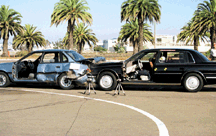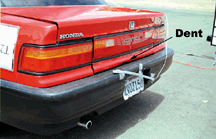The program, which has been in the works for over a year, brought together 78 of the most knowledgeable and highly trained chiropractic experts in whiplash traumatology from all over the U.S. It was a first for chiropractic, since virtually all previous such crash test research has been funded by insurers and/or the automotive industry. Tagged CRASH 99, it was a huge success, both from my perspective and those of the attendees. My hat is off to all who made this program a big success, and a special thanks to Cheryl and the other gals at SRISD.
Figure 1: Preparation for crash series A: Lincoln Continental into Honda Civic. Arrow indicates the MEA fifth wheel.
I had several goals in mind with this program. First, to introduce the most up-to-date methods for reconstructing low speed rear impact crashes (LOSRIC). Second, to give attendees a first hand look at real world low speed crashes and the resulting - and frequently dramatic - occupant kinematics. Third, to obtain high speed video of those kinematics for our upcoming documentary. Fourth, to attempt to validate the methods of LOSRIC reconstruction by comparing those calculations with the actual measured data. Fifth, to attempt to validate a new computerized digitization method of high speed (500-1000 frames/second) video and correlate those results with data obtained by triaxial accelerometers attached to the volunteers and the instruments both inside and outside of the vehicles. We also plan to do another study with the results, but I can't reveal the details right now.
This video analysis component, if it proves to be sufficiently accurate, will be a great boon to crash test research because it will allow us to selectively measure the velocity change and acceleration of both occupant and any other point within the camera's frame, thus providing a tremendous gain in flexibility, since at the present time, we have to attach accelerometers (to measure acceleration) or other devices (such as MEA fifth wheels which measure velocity parameters, from which acceleration can be derived).
Although the component will not provide triaxial data (i.e., in the three x, y and z coordinates) and will not provide the precise millisecond by millisecond accuracy of more expensive and sophisticated instrumentation, it does allow us a degree of freedom since no booms with cables need to be attached to the vehicles or occupants, and the camera is mounted off-board of the vehicle. Moreover, by rerunning the video and tagging various structures, an almost infinite analysis is possible.
Joining us for the project were Michael Freeman,DC,PhD,MPH, trauma epidemiologist/accident recon-structionist from Oregon Health Sciences University; W.R. "Rusty" Haight, an accident reconstructionist and educator at Texas A&M University; Thomas Szabo, biomechanical engineer and Judson Welcher, biomechanical engineer, both from Biomechanical Research & Testing, LLC; Jerry J. Eubanks, accident reconstructionist from Automobile Crash Causation Analysis; Adeline Yung from the Biomedical Research Institute; and several other assistant engineers and general crew. The three-day program focused on some of the common pitfalls and misconceptions surrounding low speed crash reconstruction. As usual, the San Diego weather was perfect.
Volunteers (male and female) were exposed to crash velocity changes of up to 7 mph in rear and oblique vectors of crash. We demonstrated the effects of large vehicles into smaller vehicles; smaller into larger; and small into small. We also demonstrated a higher speed sideswipe and oblique low speed side impacts, in which the occupant kinematics were relatively minimal. We looked at the difference between an aware occupant and one not prepared (to the extent that that type of simulation is possible, of course).
We also looked at the difference between braking and not braking, and between head restraints that were properly positioned and those that were not. As one might expect, the results were predictable, with more violent occupant kinematics seen in the low head restraint position. As Tom Szabo pointed out in his Sunday morning talk, it would be a good idea to take a photo of the patient sitting in their car seat just to get an idea of how their head would have reacted with the head restraint.
For the grand finale, the modest daredevil and owner of the Guinness world record for rear impact crash tests as a volunteer (he really is), Rusty Haight, volunteered for our high speed, rear impact, don't-try-this-at-home three-car pile-up.
Rusty ran our pristine 1991 Lincoln Continental into the rear of our 1989 Ford Tempo at 36 mph. The resulting crash was quite dramatic, with the rear of the Tempo caving in to about the C pillar. This locked the rear wheels so that it skidded into the broadside stationed 1991 Honda Civic, some 30 feet beyond. Rusty's delta V was 18 mph, and yes, his air bag did deploy right on time. Anyone sitting in the Tempo would probably have been very seriously injured (see Figures 2 and 3).
Figure 2: High speed rear impact crash test. Moment of impact just prior to air bag deployment. Photo courtesy of Dr. Richard Simeone.
Figure 3: Aftermath of the crash illustrated in Figure 2. This was a 36 mph closing velocity, with DV for the Lincoln and Tempo of approximately 17.5 mph.
During the crash day, which went from 7:30 AM to nearly 7:00 PM (when the cocktail party started at the hotel!), I tried to point out a few interesting findings in these LOSRIC crash tests to the attendees. For example, usually after the first run, and sometimes even after the second, even though the head contact with the head restraint is quite obvious to spectators, the volunteers frequently report that their head did not make contact. It's not clear why this rather abrupt contact is not noticeable to them. Does it happen too fast to be perceptible? Are there too many other distractions?
Whatever the reason may be, this fact does carry significance because defense experts often use the argument that since the occupant doesn't report (or recall) striking the head restraint, it must necessarily imply that no contact occurred. Therefore, the collision must have been at very low speed. It follows, they reason, that the neck would not have been exposed to injurious forces. However, it's been my experience that more often than not, the volunteers don't believe they hit the head restraint even when our high speed videotape clearly shows that they do.
Another interesting fact was that we conducted multiple crash sequences without causing significant damage to the test vehicles. This is not unlike the other reported crash tests in the literature. Several crash sequences were at closing speeds of nearly 10 mph.
Only the Honda sustained damage, mostly of a cosmetic nature to the plastic bumper fascia as it attaches to the fenders. Because the attachments sheared off, the plastic fascia hung down and rubbed against the tires. In the rear impact with the Lincoln, which has a fairly sharp nose, only a small dent occurred and the trunk lid was partially sprung (see Figure 4). Again, these observations are significant because of the common myth that one can predict occupant injury from examining the vehicle damage, or that no damage means that the crash speeds must have been below the published bumper ratings. In point of fact, we exceeded these bumper ratings in nearly every test.
Figure 4: Honda Civic rear bumper after three impacts (closing velocity) of up to 7.2 mph by Lincoln Continental and three by Ford Tempo at similar speeds.
Still another interesting observation occurred when one of our female volunteers was asked to apply the brakes, but only as hard as she normally would in traffic. She was also told to reapply the brakes immediately after the crash. Cathy turned out to be one of the faster reacting volunteers we've seen and actually had the brakes back on so fast that the impacting vehicle made a second contact right after the first. This often happens in real world crashes when occupants do see the crash coming and apply the brake vigorously. These patients will frequently report being hit twice. Don't pass it off as imaginary - it really happens.
I'll be reporting more on this crash test program as we look more closely at the data.
Click here for previous articles by Arthur Croft, DC, MS, MPH, FACO.









